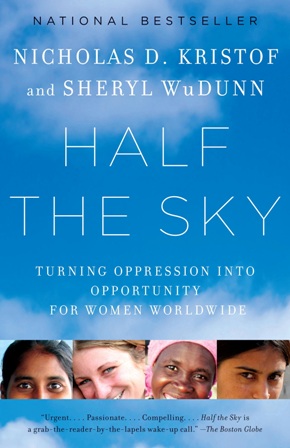
The title for Half the Sky comes from a Chinese proverb which states that women hold up half the sky.
The authors, both journalists, note that the book is an outgrowth of their own journey from focusing on “serious” foreign policy issues, like nuclear non-proliferation, to realising that news coverage of the “quotidian cruelties inflicted on women and girls” was virtually non-existent. They had two main goals in writing the book. One, to draw attention to three key areas affecting women: sex trafficking and forced prostitution, gender-based violence (including honour killings and mass rape), and maternal mortality. Two, to present solutions that they have seen work in various regions around the world. On both of their goals they have succeeded.
The book lays out, in detail, the depth of the problem of violence against women and the many forms it takes. The language is necessarily harsh at times, noting that the victims of human trafficking are seen as “discounted humans,” describing the “culture of sexual predation” that exists in many countries, talking about the “brutality inflicted on women” and the impact of female genital mutilation and fistulas caused by violent rapes, obstructed labour, and lack of medical care during childbirth.
The authors present an array of statistics to support their arguments, but they also go deeper by providing stories from women who have escaped brothels, survived extremely violent rapes and domestic violence, recovered from fistulas, and pursued an education despite lack of funds and other obstacles. These stories serve to put a face on the suffering, and enable readers to get a realistic view of the impact of violence against women.
The statistics cited in the book are overwhelming. One-third of women worldwide face beatings in the home. Women aged 15 to 44 are more likely to be maimed or die from male violence than from cancer, malaria, traffic accidents, and war combined. In 2006 in the Congolese province of South Kivu alone there were 27,000 sexual assaults. Every year 2 million women disappear because of gender discrimination. Some 536,000 women died in pregnancy or childbirth in 2005.
Yet, what could have been a very discouraging account of the seemingly intractable problem of violence against women becomes something else entirely because of the authors’ emphasis on workable solutions.
Each section of the book includes examples of individuals and small organisations that are on the ground working with local communities to devise solutions tailored to the community and its culture. Sometimes a solution is as simple as providing school uniforms so a girl can continue her education or offering her a microcredit loan so she can start a business.
Throughout all of their examples, the authors underscore one of their main arguments—that education of girls and women is the key to ensuring they can stand up to the perpetrators of violence, whether they be traffickers or their own husbands. They prove without a doubt that education empowers women by teaching them about their legal rights and family planning, raising their awareness of the tactics of traffickers, building their self-esteem, and giving them the ability to earn a living.
The authors are not afraid to challenge conventional wisdom and make some suggestions that may surprise readers. To combat sex trafficking, they do not believe in the “legalize-and-regulate” model that is favoured by many aid groups. Rather, they argue (with evidence contrasting outcomes in Sweden and Holland) that a “big-stick” approach of tougher enforcement of laws works far better in saving girls from prostitution than attempts at regulation. In one of their more controversial statements, they argue that sweatshops have given women a boost, and that Western countries should be encouraging more manufacturing in poor countries. Although they acknowledge that there are problems with sweatshops, they do not indicate how such problems would be avoided should the workforce in these low-paying jobs be expanded. They also ask the rather provocative question: is Islam misogynistic? (The answer is no.)
Despite its very dark subject, Half the Sky manages to draw readers in, keep them engaged, and inspire them with the call to action that ends the book: four easy steps to get started for people who are looking to act on violence against women but are uncertain where to begin.
Half the Sky is such an amazing book that gives life to the stories behind the statistics. This book changed my life.